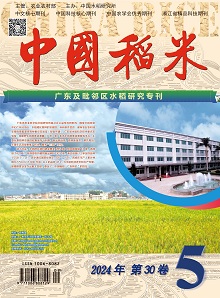This article reviewed and briefly summarized the main achievements of the Rice Research Institute of Guangdong Academy of Agricultural Sciences in rice science over the past century. In terms of rice germplasm resources, as the earliest institutions to conduct research on rice germplasm resources, the institute has collected more than 24 000 accessions of cultivated and wild rice germplasms, evaluated and screened a large number of excellent germplasm such as Waixuan 35, and created durable blast-resistant and high-quality breeding parents such as Sanhuangzhan 2, 28 Zhan, and Xiangsimiao 126 that have been widely used in the development of new varieties. In terms of rice breeding, the institute pioneered the hybrid breeding of cultivated rice and wild rice. Through artificial hybridization, it developed the first indica semi-dwarf rice variety Guangchangai, which was widely used in production, thereby opening up a new path for rice dwarf breeding. This led to the rapidly development of major varieties such as Zhenzhuai, Guangluai 4, Guichao 2, Shuanggui 36, and Teqing, and played a significant role in facilitating the First Green Revolution in agricultural history. As one of the earliest institutions to engage in indica high-quality rice breeding, it has successively developed high-quality new varieties such as Shuangzhuzhan, Huanghuazhan, Yuenongsimiao, Meixiangzhan 2, Taifengyou 208, etc., which are planted on a large scale. In hybrid rice breeding, the institute has created wild-abortive type and Honglian type three-line male sterile lines such as Tianfeng A, Wufeng A, Rongfeng A, Congguang 41A, Yuetai A, Yuefeng A, Taifeng A, and Guang 8A, with high combining ability and outcrossing rate, slender grain type and high grain quality. It has also developed temperature-and photoperiod-sensitive restorer lines such as Guanghui 3550, Guanghui 998, and Guanghui 122, which are widely used in hybrid rice breeding and production. The institute has led or collaborated in the development of 45 rice varieties (combinations) with a cumulative planting area exceeding 0.67 million hectares. In rice cultivation techniques, from the summarization of farmers’ high-yield rice cultivation experience, known as the “Chaoshan Experience”, in the 1950s—1960s, to the research on technical regulations for high-yield rice cultivation in the 1980s, the development of rice seedling-throwing technology in the 1990s, and the “three controls” nutrient management technology for rice in the 2000s, etc., the research and development of these cultivation techniques have achieved the integration of good varieties with good methods, playing an extremely important role in achieving high and stable rice grain yields and ensuring the national food security.

